Distribution and Genesis of the Deep Buried, Fractured and Vuggy Dolostone Reservoir in the Lower Ordovician Succession, North Tarim Basin, Northwestern China
Abstract
1. Introduction
2. Geological Settings
2.1. Geography and Location
2.2. Tectonics and Unconformity
2.3. Stratigraphy
3. Methods
3.1. Petrography and Cathodoluminescence
3.2. Fluid Inclusion Microthermometry
3.3. Carbon and Oxygen Isotopes
3.4. Radiogenic Sr Isotopes
4. Results
4.1. Pore Types of Reservoir
4.2. Petrography of Reservoir Rocks
4.3. Homogenization Temperature of Fluid Inclusions
4.4. Carbon and Oxygen Isotopic Ratios
4.5. Radiogenic Sr Isotopic Ratios
5. Discussion
5.1. Paragenetic Sequence in Reservoir Rocks

5.2. Pore Space Development and Karst Dissolution
5.3. Distribution of Reservoir and Freshwater Channel
5.4. Genesis of Vuggy and Fractured Dolostone Reservoir
6. Conclusions
- (1)
- The Lower Ordovician dolostone reservoirs in the southern part of the Tabei uplift exhibit pore space characterized by fractures and vugs. Based on the petrographical, cathodoluminescent, and fluid inclusion microthermometric characteristics of carbonate and quartz fabrics, we built up the diagenetic paragenetic sequence. It indicates that prior to the occurrence of dissolution creating the pore space, the strata had already reached a certain depth (as evidenced by the stylolites in the overlying limestones).
- (2)
- Inter-breccia calcite cements act as the key clue for the nature of dissolving fluid in this study. Isotopic analyses reveal that the fluid responsible for the dissolution was sourced from meteoric freshwater during the Devonian period.
- (3)
- At the micro scale, dissolution often manifests as the dissolution and enlargement of pre-existing calcite cements and fractures. At the macroscale, seismic reflections of karstic fault reservoirs distinctly demonstrate distribution along strike-slip faults. This reservoir distribution features at different scales which collectively indicate that faults serve as karst channels for meteoric freshwater dissolution in the southern part of the Tarim Uplift.
- (4)
- The formation of karstic fault reservoirs in the southern Tarim Basin uplift is influenced by the formation of strike-slip faults and exposure of the overlying strata to the surface. Meteoric freshwater from the surface percolated downward along deep-seated strike-slip faults, causing dissolution in the unexposed Middle-Lower Ordovician strata. This process resulted in the formation of string-like karstic fault reservoirs distributed along strike-slip faults.
Author Contributions
Funding
Data Availability Statement
Conflicts of Interest
References
- Ford, D.C.; Ewers, R.O. The development of limestone cave systems in the dimensions of length. Can. J. Earth Sci. 1978, 15, 1783–1798. [Google Scholar] [CrossRef]
- He, Y.B. Hydrodynamic Profile of Homogeneous Thick Limestone and Its Practical Significance. China Karst 1991, 4, 1–12. [Google Scholar]
- Ford, D.C.; Williams, P.W. Karst Hydrogeology and Geomorphology; Wiley: Chichester, UK, 2007; 562p. [Google Scholar]
- Zhang, B.M.; Liu, J.J. Classification and characteristics of karst reservoirs in China and related theories. Pet. Explor. Dev. 2009, 36, 12–31. [Google Scholar]
- Fritz, R.D.; Medlock, P.; Kuykendall, M.J.; Wilson, J.L. The Geology of the Arbuckle Group in the Midcontinent: Sequence Stratigraphy, Reservoir Development, and the Potential for Hydrocarbon Exploration. In AAPG Annual Convention and Exhibition, Pittsburgh, Pennsylvania, Search and Discovery Article; The American Association of Petroleum Geologists: Tulsa, OK, USA, 2013; p. 30266. [Google Scholar]
- King, B.D.; Goldstein, R.H. History of hydrothermal fluid flow in the midcontinent, USA: The relationship between inverted thermal structure, unconformities and porosity distribution. In Reservoir Quality of Clastic and Carbonate Rocks: Analysis, Modelling and Prediction; Armitage, P.J., Butcher, A.R., Churchill, J.M., Csoma, A.E., Hollis, C., Lander, R.H., Omma, J.E., Worden, R.H., Eds.; Geological Society, Special Publications: London, UK, 2018; Volume 435, pp. 283–320. [Google Scholar]
- Medici, G.; Lorenzi, V.; Sbarbati, C.; Manetta, M.; Petitta, M. Structural classification, discharge statistics, and recession analysis from the springs of the Gran Sasso (Italy) carbonate aquifer; comparison with selected analogues worldwide. Sustainability 2023, 15, 10125. [Google Scholar] [CrossRef]
- Brett, C.E.; Goodman, W.M.; Loduca, S.T.; Tetreault, D. Silurian-Early Devonian sequence stratigraphy, events, and paleoenvironments of western New York and Ontario, Canada. In New York State Geological Association 71st Annual Meeting, Field Trip Guidebook; Department of Geosciences SUNY College: Fredonia, NY, USA, 1999. [Google Scholar]
- Loucks, R.G. Review of the Lower Ordovician Ellenburger Group of the Permian Basin, West Texas; Ellenburger Draft; Online; 2008; 95p. [Google Scholar]
- Davies, G.; Smith, L. Structurally controlled hydrothermal dolomite reservoir facies: An overview. AAPG Bull. 2006, 90, 1641–1690. [Google Scholar] [CrossRef]
- Ford, D.C. Karst geomorphology, caves and cave deposits: A review of North American contributions during the past half century. In Perspectives on Karst Geomorphology, Hydrology and Geochemistry; GSA Special Paper, 404; Harmon, R.S., Wicks, C.W., Eds.; John Wiley & Sons: Boulder, Colorado, USA, 2006; pp. 1–14. [Google Scholar]
- Klimchouk, A. Morphogenesis of hypogenic caves. Geomorphology 2009, 106, 100–117. [Google Scholar] [CrossRef]
- Kang, Z.J. Cases of Discovery and Exploration of Marine Fields in China (Part 4): Tahe Oilfield in Tarim Basin. Mar. Oil Gas Geol. 2005, 10, 31–38. [Google Scholar]
- Zhou, X.Y.; Yang, H.J.; Han, J.F.; Wang, F.H.; Han, J. Cases of Discovery and Exploration of Marine Fields in China (Part 12): Lunnan Ordovician Oil-Gas Field in Tarim Basin. Mar. Oil Gas Geol. 2009, 14, 67–77. [Google Scholar]
- Zhu, G.Y.; Zhang, S.C.; Zhang, B. Reservoir types of marine carbonates and their accumulation model in western and central China. Acta Pet. Sin. 2010, 31, 871–878. [Google Scholar]
- Derby, J.; Fritz, R.; Longacre, S.; Morgan, W.; Sternbach, C. The Great American Carbonate Bank: The Geology and Economic Resources of the Cambrian-Ordovician Sauk Megasequence of Laurentia; AAPG Memoir; AAPG: Tulsa, OK, USA, 2012; Volume 98, 1210p. [Google Scholar]
- Yan, W.; Wang, X.Z.; Ding, Y. The discovery and characteristics of covered-pressurization karst during early Hercynian in south Tahe oilfield. J. Southwest Pet. Univ. (Sci. Technol. Ed.) 2011, 33, 53–60. [Google Scholar]
- Lyu, Y.P.; Zhao, X. Study on reservoir forming mechanism and development mode of distribution of Ordovician carbonate in the southeast slope area of Tahe oilfield. J. Mineral. Petrol. 2012, 32, 107–115. [Google Scholar]
- Han, C.C.; Lin, C.Y.; Ren, L.H.; Lu, X.B.; Wei, T.; Zhang, X. Characteristics of Ordovician fault in the Block 10 of Tahe Oilfield, Tarim Basin and its controlling effect on karst reservoirs. Nat. Gas Geosci. 2016, 27, 790–798. [Google Scholar]
- Li, H.; Li, G.R.; Luo, Y.; Fu, H.; Gao, Y.W.; Zhu, Y.Y.; Zhang, W. Characteristics of Hydrothermal Fluid in Deep Ordovician Carbonate Reservoirs in Tahe Area. J. Northeast Pet. Univ. 2014, 38, 12–23. [Google Scholar]
- Jia, C.Z. Structural Characteristics and Oil and Gas in Tarim Basin; Petroleum Industry Press: Beijing, China, 1997; 438p. [Google Scholar]
- Zhang, G.Y.; Zhao, W.Z.; Wang, H.J.; Li, H.H.; Liu, L. Multicycle tectonic evolution and composite petroleum systems in the Tarim Basin. Oil Gas Geol. 2007, 28, 653–663. [Google Scholar]
- Meng, X.X.; Wang, H.B.; Yao, Q.Z. Tectonic Evolution Characteristics of Tabei Uplift and Its Controlling Effect on the Reservoir and Hydrocarbon Accumulation of Ordovician Carbonate. Nat. Gas Geosci. 2015, 26, 109–120. [Google Scholar]
- He, D.F.; Jia, C.Z.; Li, D.S.; Zhang, C.J.; Meng, Q.R.; Shi, X. Formation and evolution of polycyclic superimposed Tarim Basin. Oil Gas Geol. 2005, 26, 64–77. [Google Scholar]
- Qi, L.X.; Yun, L. Development characteristics and main controlling factors of the Ordovician carbonate karst in Tahe oilfield. Oil Gas Geol. 2010, 31, 1–12. [Google Scholar]
- Lyu, H.T.; Zhang, D.J.; Yang, Y.C. Stages of Paleokarstic Hypergenesis in Ordovician Reservoir, Tahe Oilfield. Geol. Sci. Technol. Inf. 2009, 28, 71–75, 83. [Google Scholar]
- Lin, C.S.; Li, S.T.; Liu, J.Y.; Qian, Y.; Luo, H.; Chen, J.; Peng, L.; Rui, Z. Tectonic framework and paleogeographic evolution of the Tarim basin during the Paleozoic major evolutionary stages. Acta Petrol. Sin. 2011, 1, 210–218. [Google Scholar]
- Lu, X.; Wang, Y.; Tian, F.; Li, X.; Yang, D.; Li, T.; Lv, Y.; He, X. New Insights into the Carbonate Karstic Fault System and Reservoir Formation in the Southern Tahe Area of the Tarim Basin. Mar. Pet. Geol. 2017, 86, 587–605. [Google Scholar] [CrossRef]
- Goldstein, R.H.; Reynolds, T. Systematics of Fluid Inclusions in Diagenetic Minerals; Society for Sedimentary Geology: Tulsa, OK, USA, 1994. [Google Scholar]
- Friedman, I.; O’Neil, J.R. Data of Geochemistry: Compilation of Stable Isotope Fractionation Factors of Geochemical Interest; US Government Printing Office: Washington, DC, USA, 1977.
- Rosenbaum, J.; Sheppard, S. An isotopic study of siderites, dolomites and ankerites at high temperatures. Geochim. Cosmochim. Acta 1986, 50, 1147–1150. [Google Scholar] [CrossRef]
- Veizer, J.; Ala, D.; Azmy, K.; Bruckschen, P.; Buhl, D.; Bruhn, F.; Carden, G.A.; Diener, A.; Ebneth, S.; Godderis, Y.; et al. 87Sr/86Sr, δ13C and δ18O evolution of Phanerozoic seawater. Chem. Geol. 1999, 161, 59–88. [Google Scholar] [CrossRef]
- Lu, Z.; Chen, H.; Qing, H.; Chi, G.; Chen, Q.; You, D.; Yin, H.; Zhang, S. Petrography, Fluid Inclusion and Isotope Studies in Ordovician Carbonate Reservoirs in the Shunnan Area, Tarim basin, NW China: Implications for the Nature and Timing of Silicification. Sediment. Geol. 2017, 359, 29–43. [Google Scholar] [CrossRef]
- Li, J.; Cai, Z.X. The Role of Seal and Source Rocks in Fluid-rock Interactions and their Reservoir Effects within the Carbonate Deep Burial Realm. Acta Geol. Sin. (Engl. Ed.) 2022, 96, 1353–1361. [Google Scholar] [CrossRef]
- Li, J.; Cai, Z.X. Development and Preservation Mechanism of Deep High-Quality Dolostone Reservoirs; University of Geosciences Press: Wuhan, China, 2022; 147p. [Google Scholar]
- Dong, S.F.; Chen, D.Z.; Qing, H.R.; Zhou, X.; Wang, D.; Guo, Z.; Jiang, M.; Qian, Y. Hydrothermal alteration of dolostones in the Lower Ordovician, Tarim Basin, NW China: Multiple constraints from petrology, isotope geochemistry and fluid inclusion microthermometry. Mar. Pet. Geol. 2013, 46, 270–286. [Google Scholar] [CrossRef]
- Jin, Z.J.; Zhu, D.Y.; Meng, Q.Q.; Hu, W. Hydrothermal activities and influences on migration of oil and gas in Tarim Basin. Acta Petrol. Sin. 2013, 29, 1048–1058. [Google Scholar]
- Zhu, D.Y.; Meng, Q.Q.; Jin, Z.J.; Liu, Q.; Hu, W. Formation mechanism of deep Cambrian dolomite reservoirs in the Tarim basin, northwestern China. Mar. Pet. Geol. 2015, 59, 232–244. [Google Scholar] [CrossRef]
- Zhang, Y.M.; Zhang, S.N.; Huang, B.W.; Lu, Z.; Ye, N.; Zhu, B.; Hou, X.; Xie, F.; Bai, X.; Zhang, X. Fluid Inclusion, Isotopic, and Elemental Geochemistry Studies of Cave-Filling Calcite in the Lower–Middle Ordovician Yingshan Formation of Tahe Oilfield, NW China: Implication for Karstification in Non-exposed Limestone. Front. Earth Sci. 2022, 10, 842386. [Google Scholar] [CrossRef]
- Feng, T. Analysis on the Difference of Hydrocarbon Accumulation of the Ordovician in Tahe Area and Its Peripheral Area, Tarim Basin. Master’s Thesis, Yangtze University, Jingzhou, China, 2023; 67p. [Google Scholar]
- Rossi, C.; Goldstein, R.H.; Ceriani, A.; Marfil, R. Fluid Inclusions Record thermal and Fluid Evolution in Reservoir Sandstones, Khatatba Formation, Western Desert, Egypt: A Case for Fluid Injection. AAPG Bull. 2002, 86, 1773–1799. [Google Scholar]
- Ainsaar, L.; Kaljo, D.; Martma, T. Middle and Upper Ordovician Carbon Isotope Chemostratigraphy in Baltoscandia: A Correlation Standard and Clues to Environmental History. Palaeogeogr. Palaeoclimatol. Palaeoecol. 2010, 294, 189–201. [Google Scholar] [CrossRef]
- Bourdin, C.; Douville, E.; Genty, D. Alkaline-Earth Metal and Rare Earth Element Incorporation Control by Ionic Radius and Growth Rate on a Stalagmite from the Chauvet Cave, Southeastern France. Chem. Geol. 2011, 290, 1–11. [Google Scholar] [CrossRef]
- Han, C.; Lin, C.; Lu, X.; Tian, J.; Ren, L.; Ma, C. Petrological and Geochemical Constraints on Fluid Types and Formation Mechanisms of the Ordovician Carbonate Reservoirs in Tahe Oilfield, Tarim Basin, NW China. J. Pet. Sci. Eng. 2019, 178, 106–120. [Google Scholar] [CrossRef]
- Zhang, T.; Yun, L.; Wu, X.; Ye, D. The Application of Strontium Isotopes in Division of Paleokarst Stages in Tahe Oilfield. Pet. Geol. Explor. 2005, 27, 299–303. [Google Scholar]
- Zeng, H.L.; Wang, G.; Janson, X.; Loucks, R.; Xia, Y.; Xu, L.; Yuan, B. Characterizing seismic bright spots in deeply buried, Ordovician paleokarst strata, central Tabei Uplift, Tarim basin, western China. Geophysics 2011, 76, B127–B137. [Google Scholar] [CrossRef]
- Sun, S.Z.; Liu, Z.; Dong, N. Fluid Prediction for Paleokarst Carbonate Reservoir; SEG Technical Program Expanded Abstracts; Society of Exploration Geophysicists: Houston, TX, USA, 2015; pp. 2821–2825. [Google Scholar]
- Yang, X.; Wang, X.; Tang, H.; Ding, Y.; Lv, H.; Liu, C. The Early Hercynian Paleo-Karstification in the Block 12 of Tahe Oilfield, Northern Tarim Basin, China. Carbonates Evaporites 2014, 29, 251–261. [Google Scholar] [CrossRef]
- Méndez, J.N.; Jin, Q.; González, M.; Zhang, X.; Lobo, C.; Boateng, C.D.; Zambrano, M. Fracture Characterization and Modeling of Karsted Carbonate Reservoirs: A Case Study in Tahe Oilfild, Tarim Basin (Western China). Mar. Pet. Geol. 2019, 112, 104104. [Google Scholar] [CrossRef]
- Lin, B.; Zhang, X.; Xu, X.; Yuan, J.; Neng, Y.; Zhu, J. Features and effects of basement faults on deposition in the Tarim basin. Earth-Sci. Rev. 2015, 145, 43–55. [Google Scholar] [CrossRef]
- Wang, Q.H.; Yang, H.J.; Li, Y.; Lü, X.; Zhang, Y.; Zhang, Y.; Su, C.; Ouyang, S. Control of strike-slip fault on the large carbonate reservoir in Fuman, Tarim Basin a reservoir model. Earth Sci. Front. 2022, 29, 239–251. [Google Scholar]
- Yun, L.; Deng, S. Structural styles of deep strike-slip faults in Tarim Basin and the characteristics of their control on reservoir formation and hydrocarbon accumulation: A case study of Shunbei oil and gas field. Acta Pet. Sin. 2022, 42, 770–787. [Google Scholar]
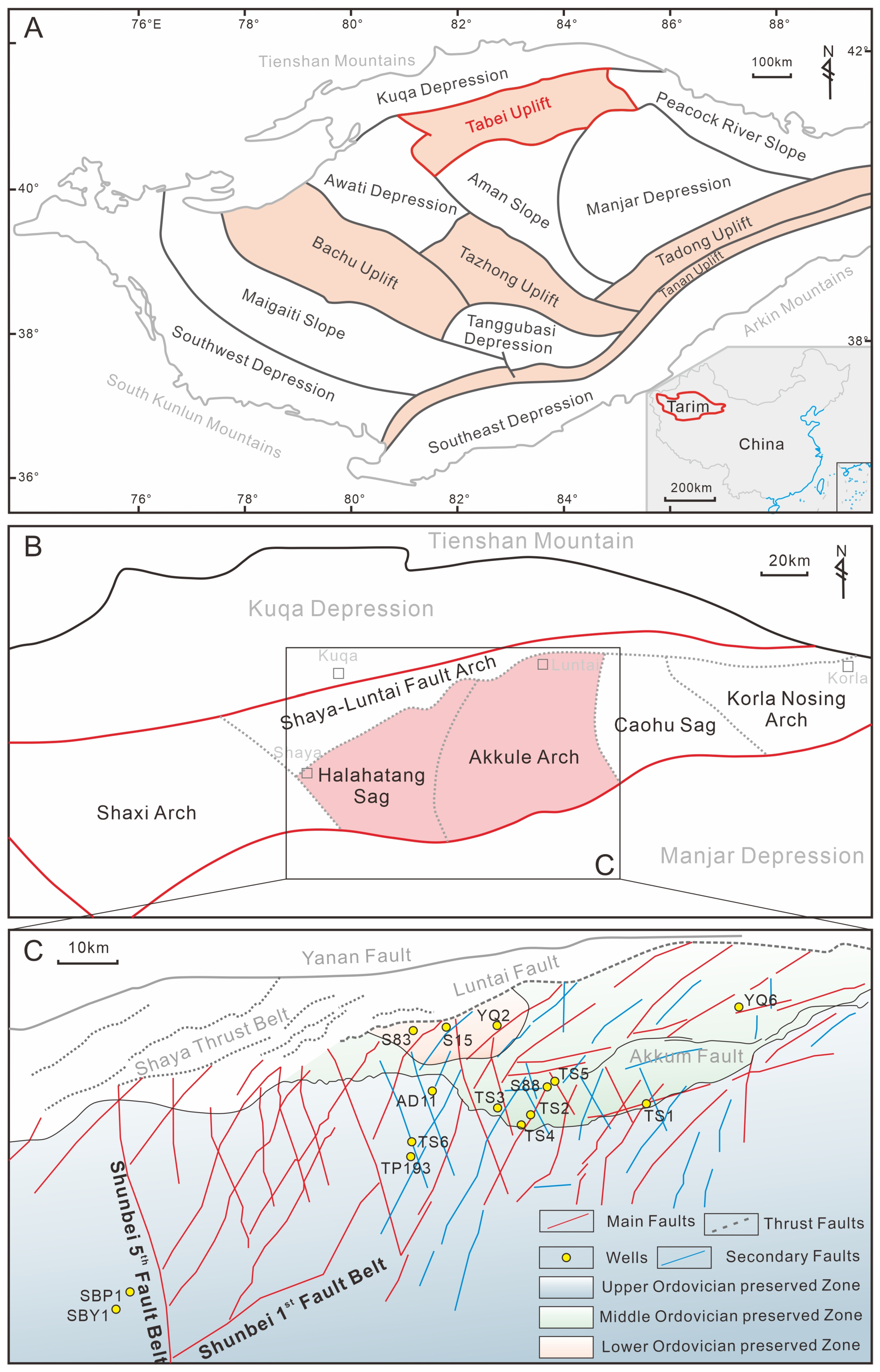
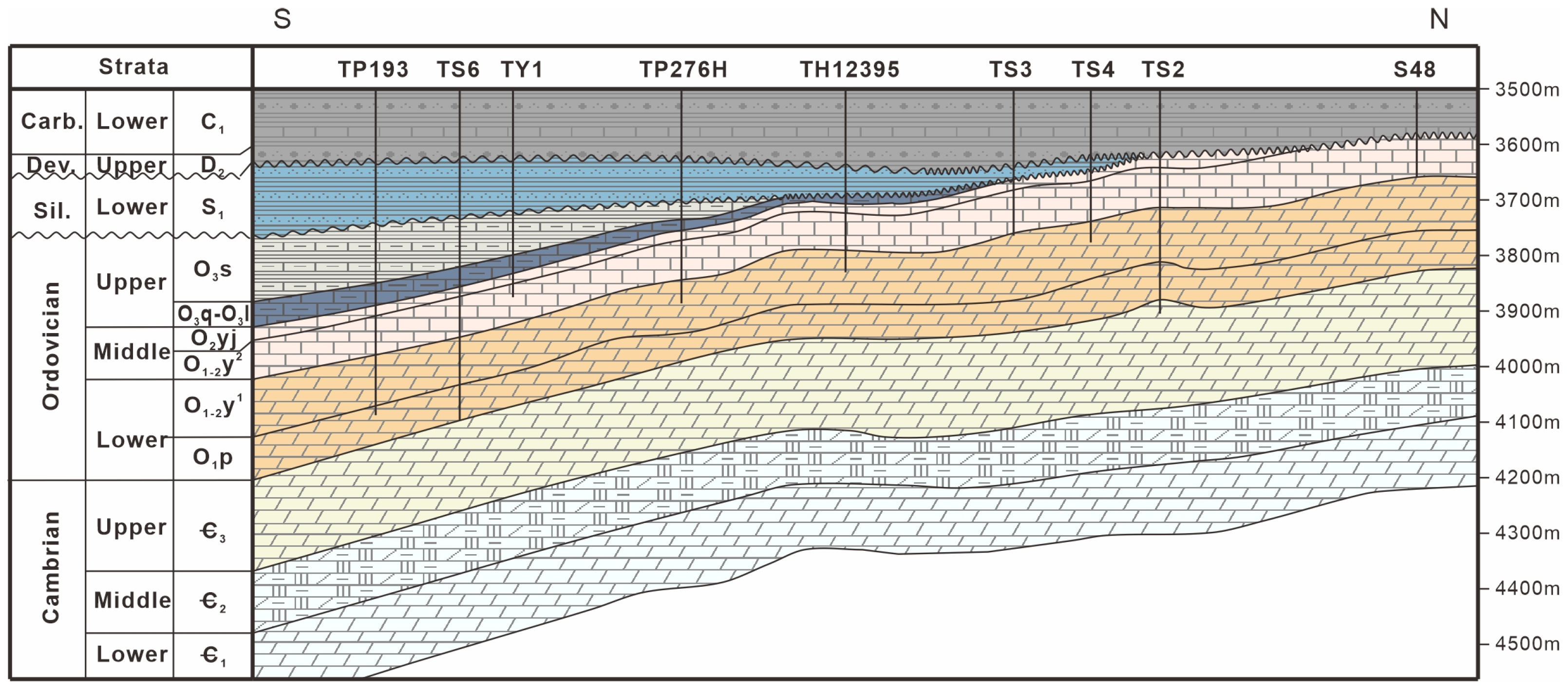
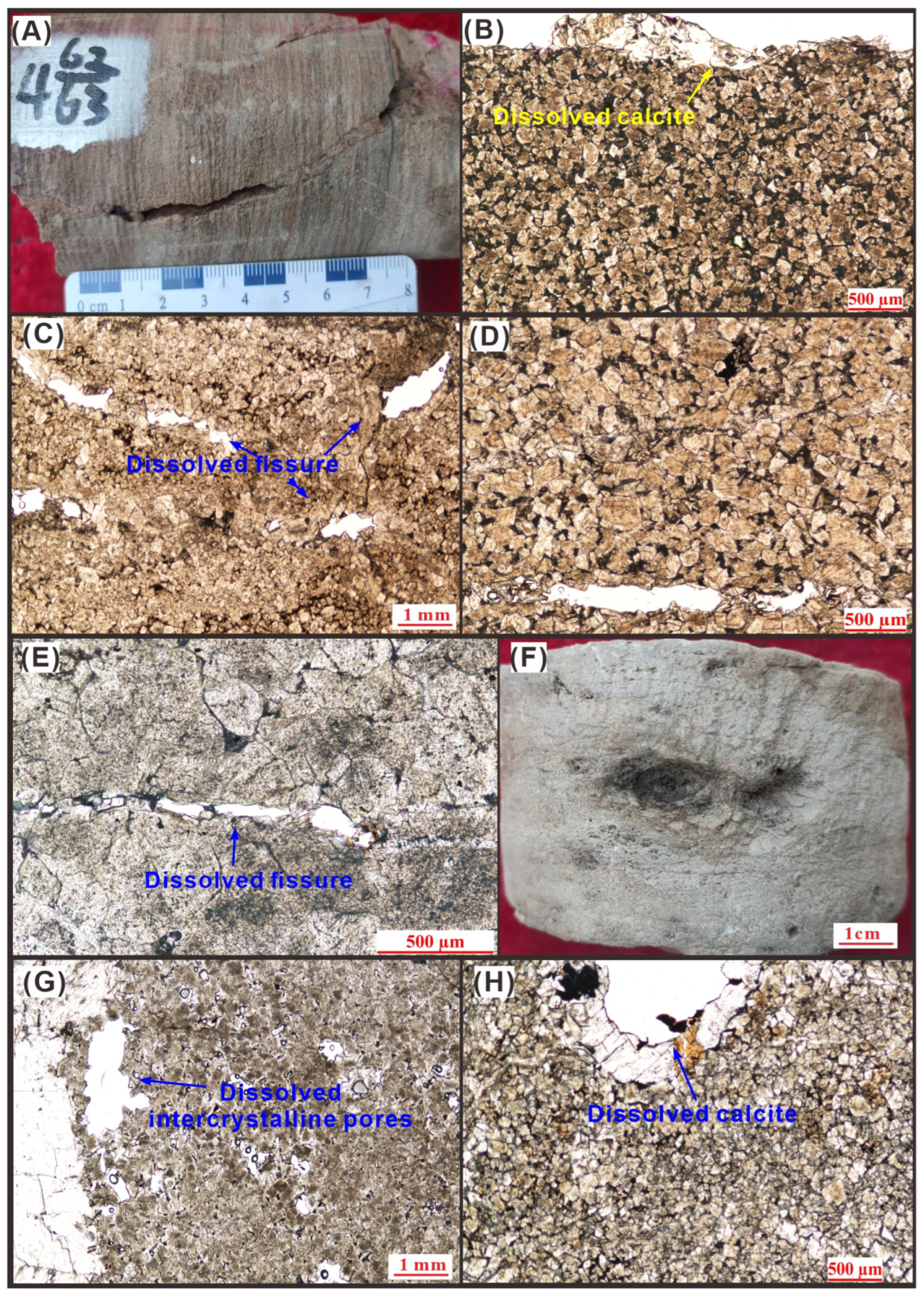
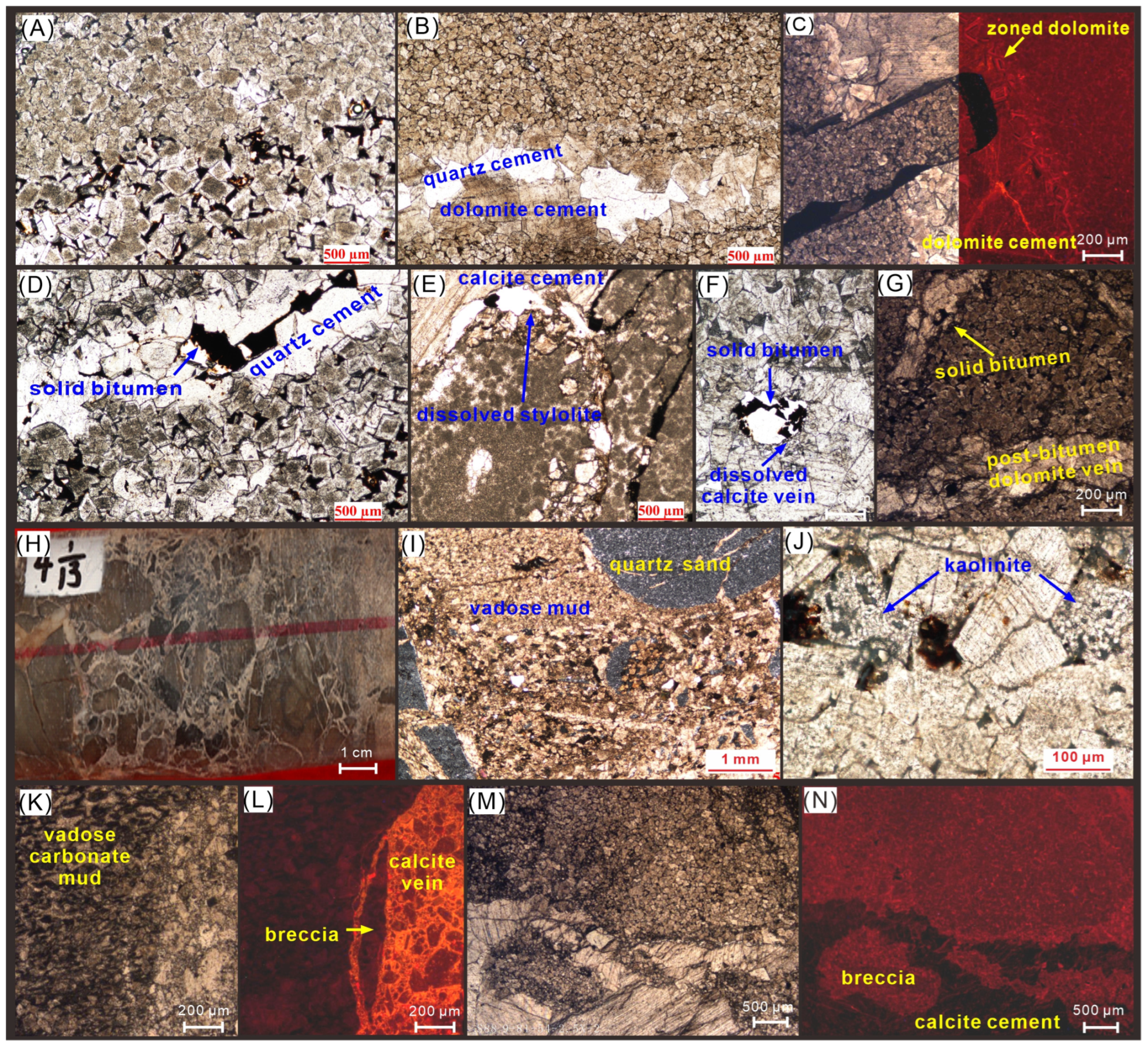
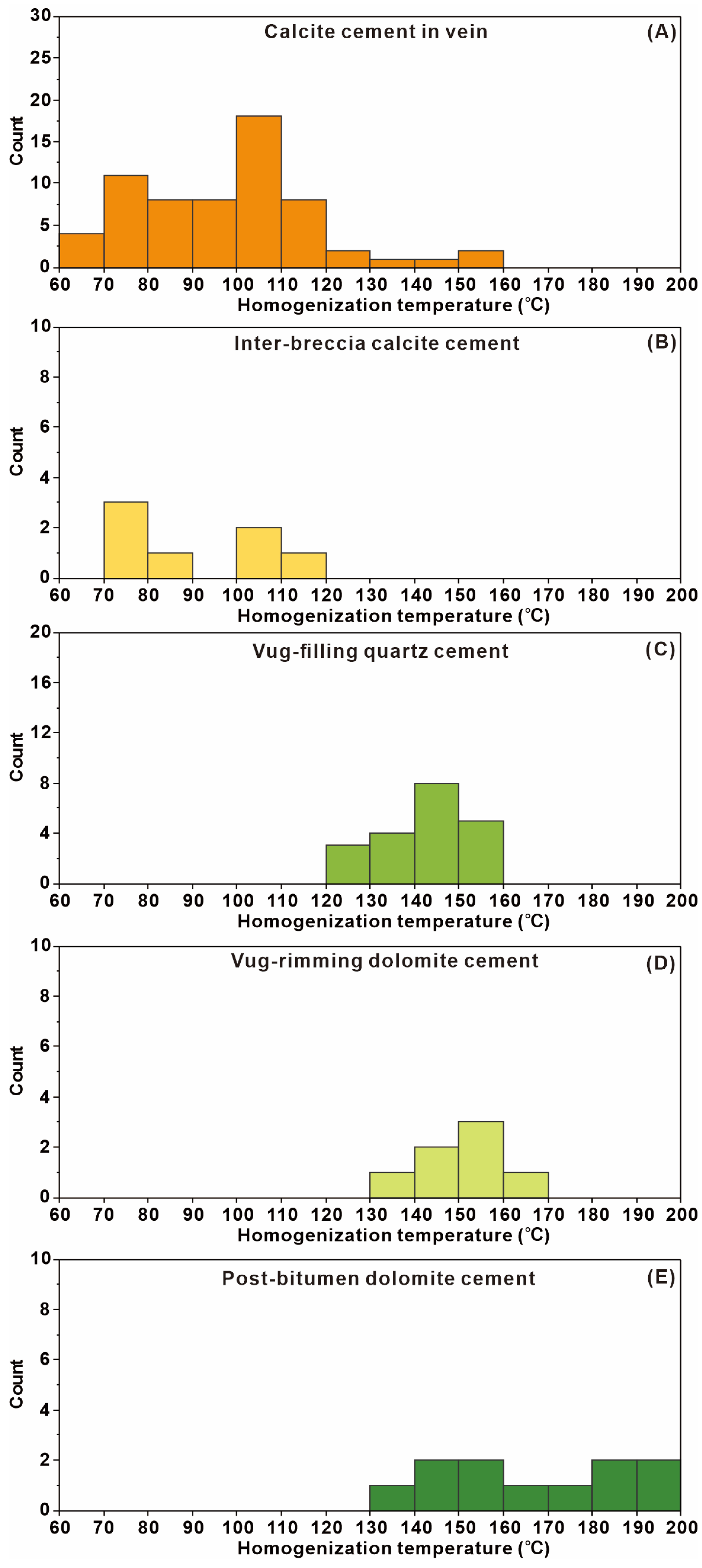
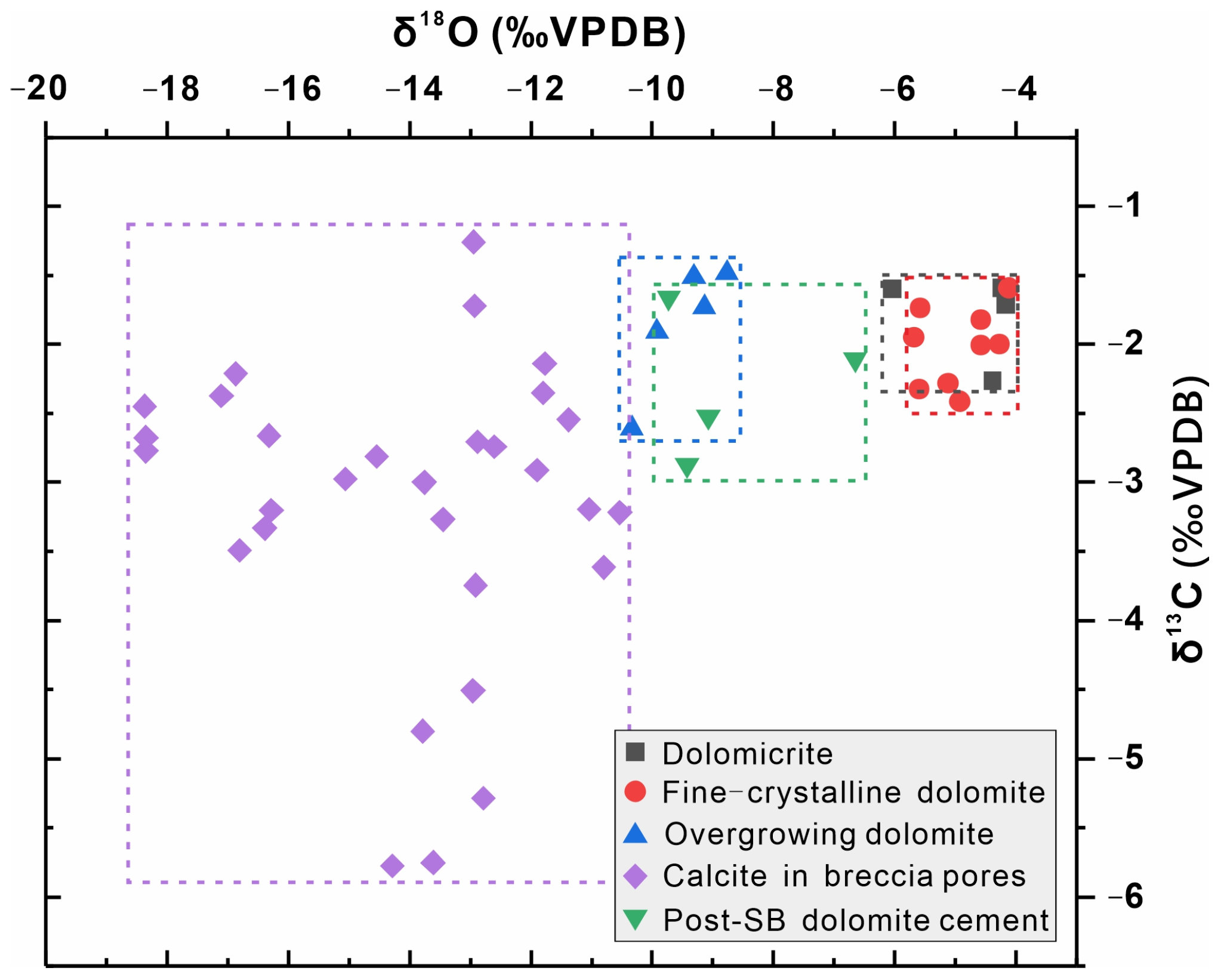
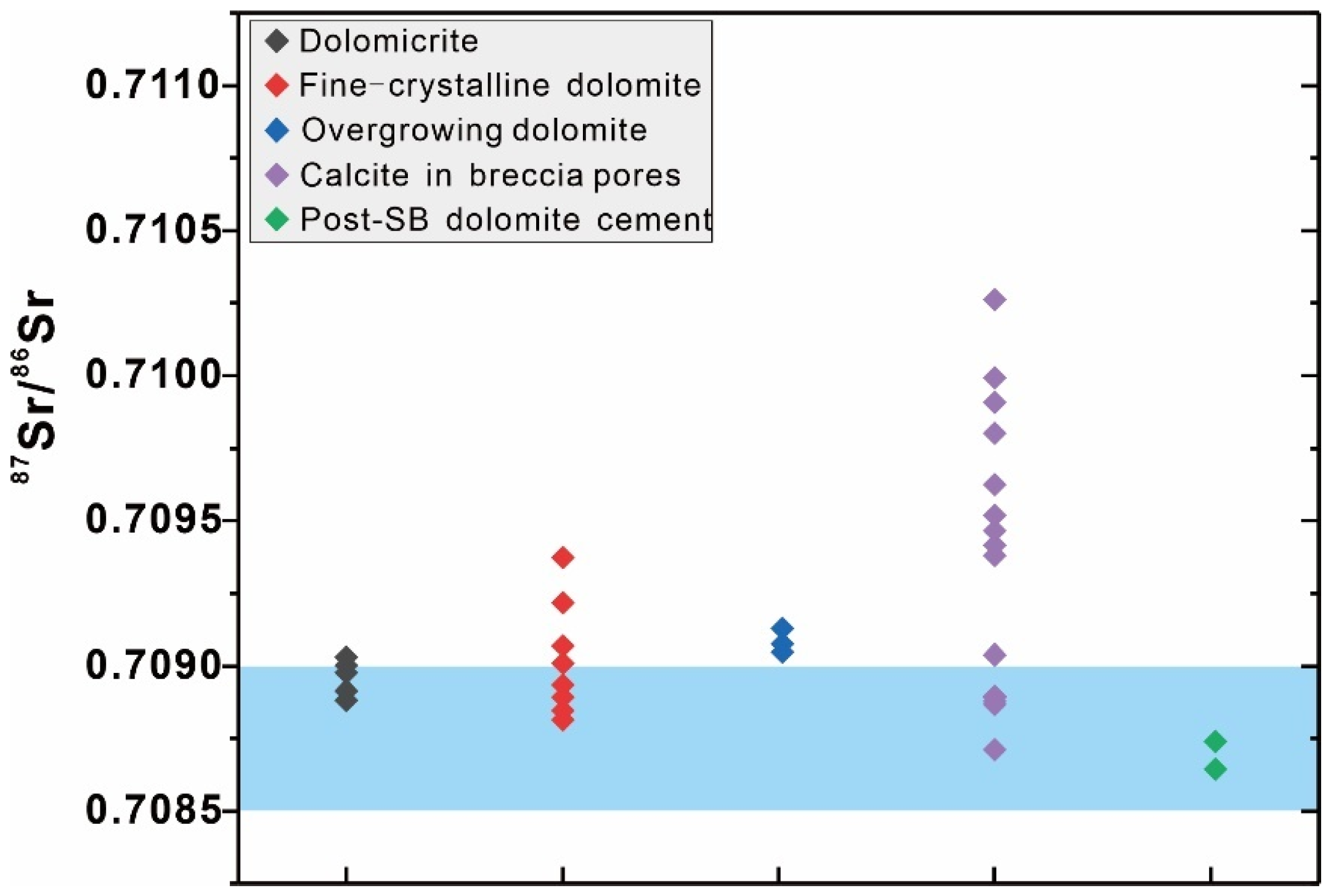
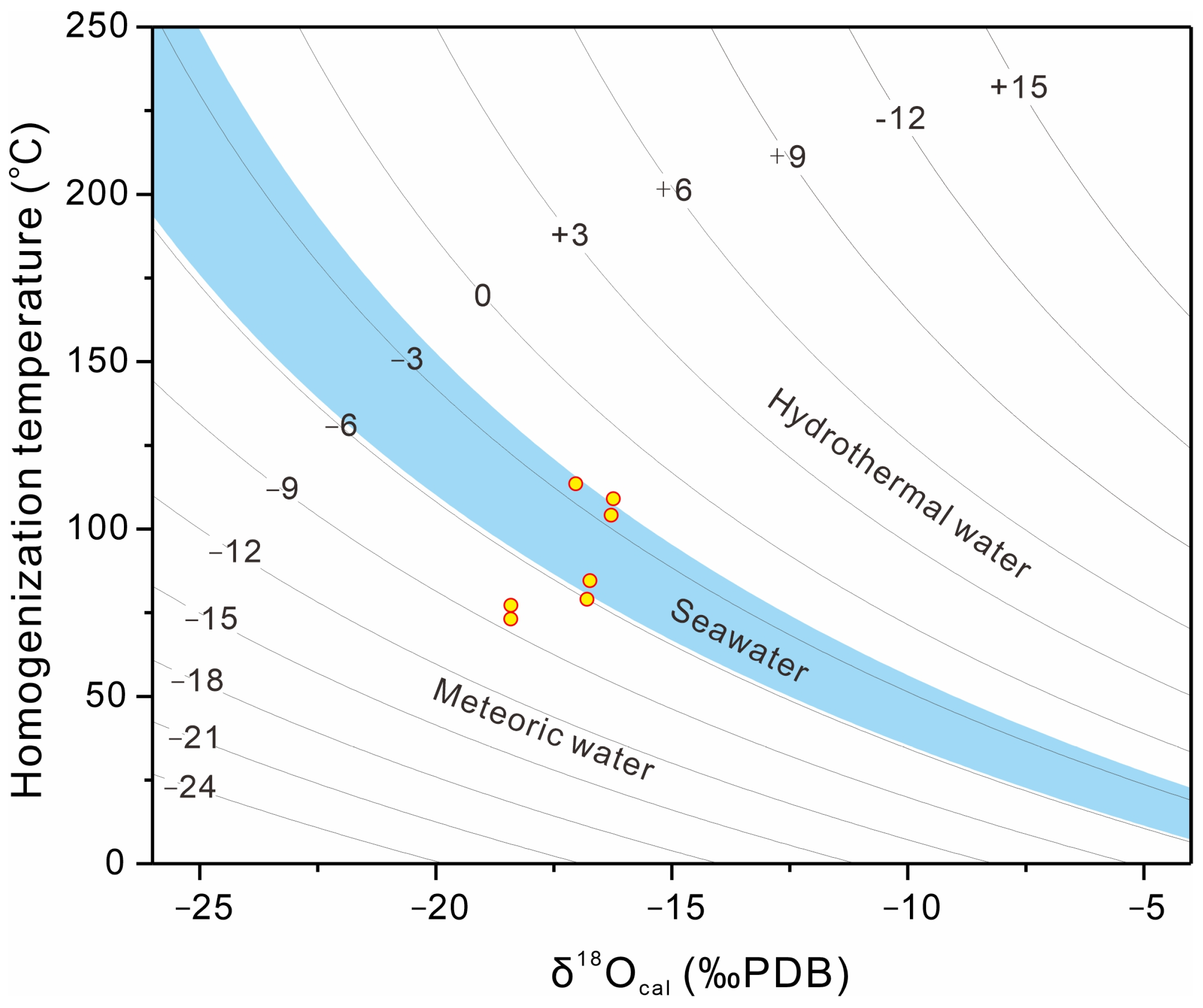
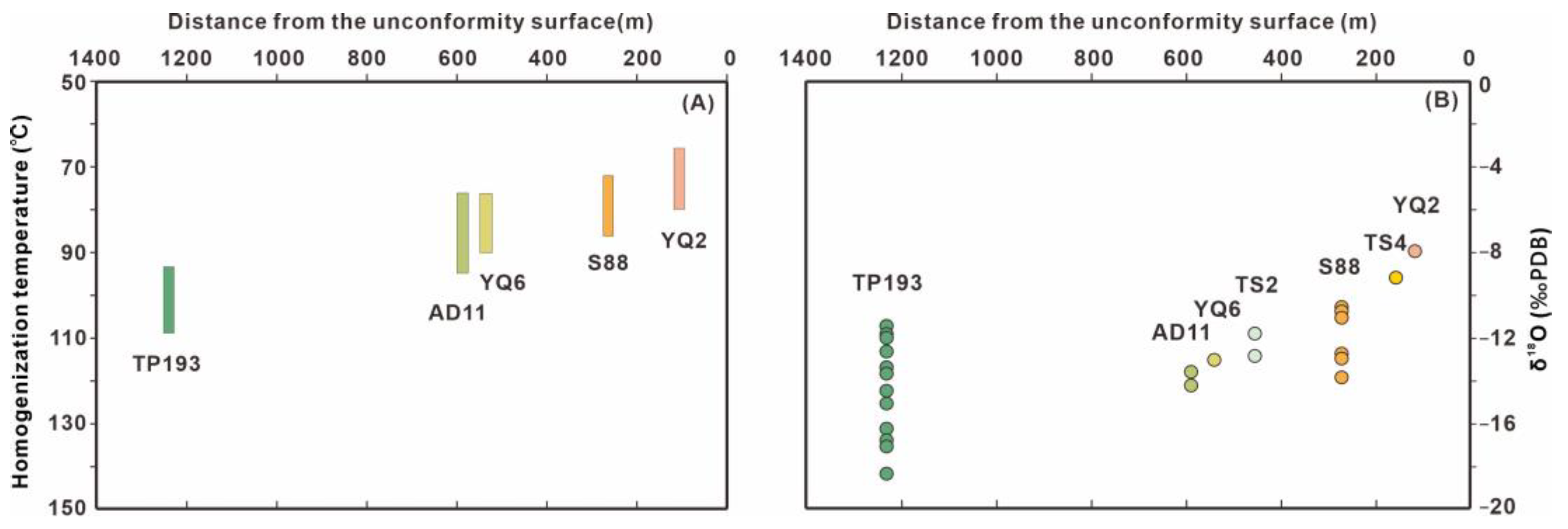
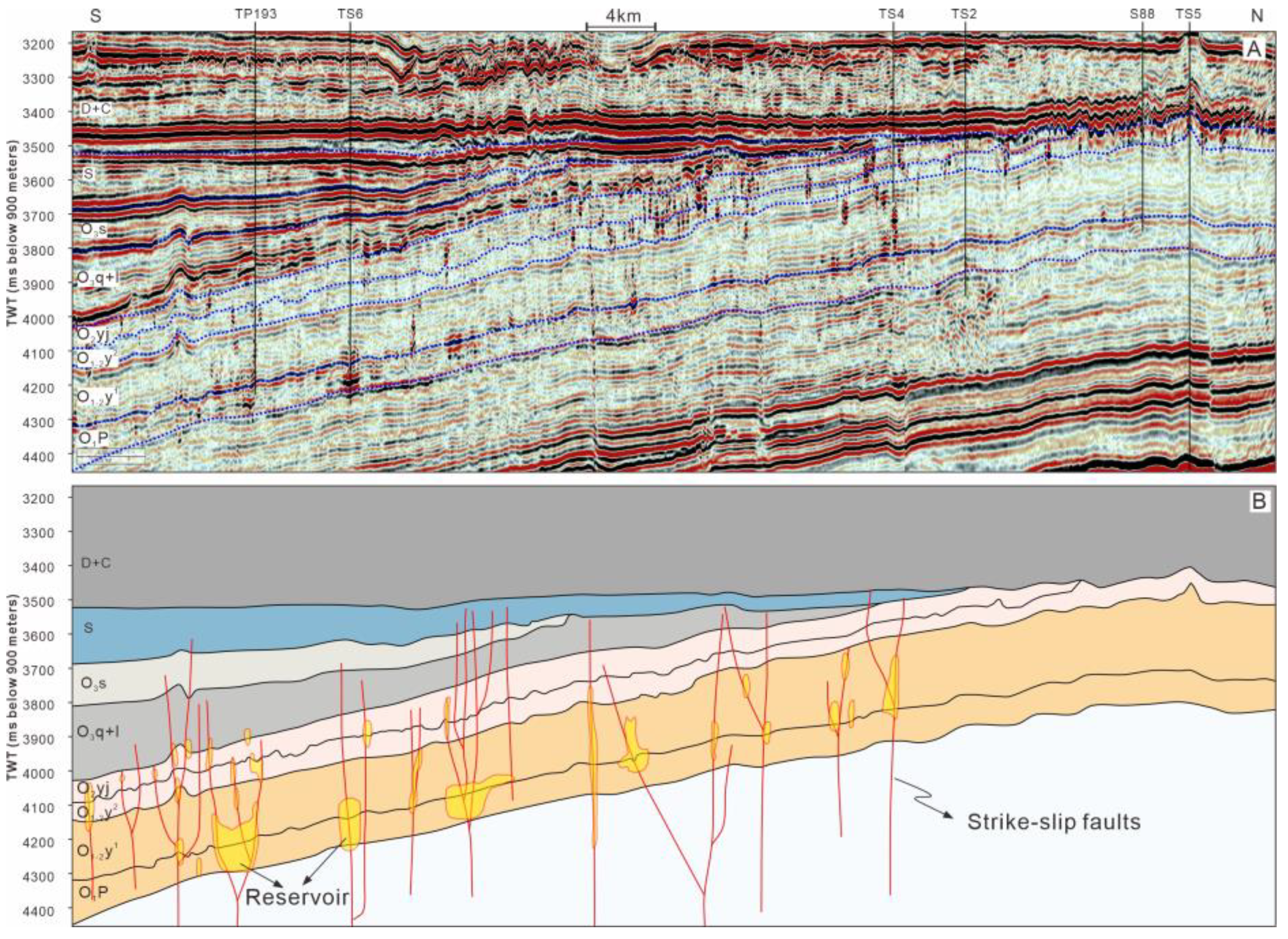

Disclaimer/Publisher’s Note: The statements, opinions and data contained in all publications are solely those of the individual author(s) and contributor(s) and not of MDPI and/or the editor(s). MDPI and/or the editor(s) disclaim responsibility for any injury to people or property resulting from any ideas, methods, instructions or products referred to in the content. |
© 2024 by the authors. Licensee MDPI, Basel, Switzerland. This article is an open access article distributed under the terms and conditions of the Creative Commons Attribution (CC BY) license (https://creativecommons.org/licenses/by/4.0/).
Share and Cite
Gao, L.; Li, J.; Li, G.; Fu, L.; Liu, Y. Distribution and Genesis of the Deep Buried, Fractured and Vuggy Dolostone Reservoir in the Lower Ordovician Succession, North Tarim Basin, Northwestern China. Minerals 2024, 14, 58. https://doi.org/10.3390/min14010058
Gao L, Li J, Li G, Fu L, Liu Y. Distribution and Genesis of the Deep Buried, Fractured and Vuggy Dolostone Reservoir in the Lower Ordovician Succession, North Tarim Basin, Northwestern China. Minerals. 2024; 14(1):58. https://doi.org/10.3390/min14010058
Chicago/Turabian StyleGao, Lijun, Jie Li, Guorong Li, Liyun Fu, and Yongli Liu. 2024. "Distribution and Genesis of the Deep Buried, Fractured and Vuggy Dolostone Reservoir in the Lower Ordovician Succession, North Tarim Basin, Northwestern China" Minerals 14, no. 1: 58. https://doi.org/10.3390/min14010058
APA StyleGao, L., Li, J., Li, G., Fu, L., & Liu, Y. (2024). Distribution and Genesis of the Deep Buried, Fractured and Vuggy Dolostone Reservoir in the Lower Ordovician Succession, North Tarim Basin, Northwestern China. Minerals, 14(1), 58. https://doi.org/10.3390/min14010058




